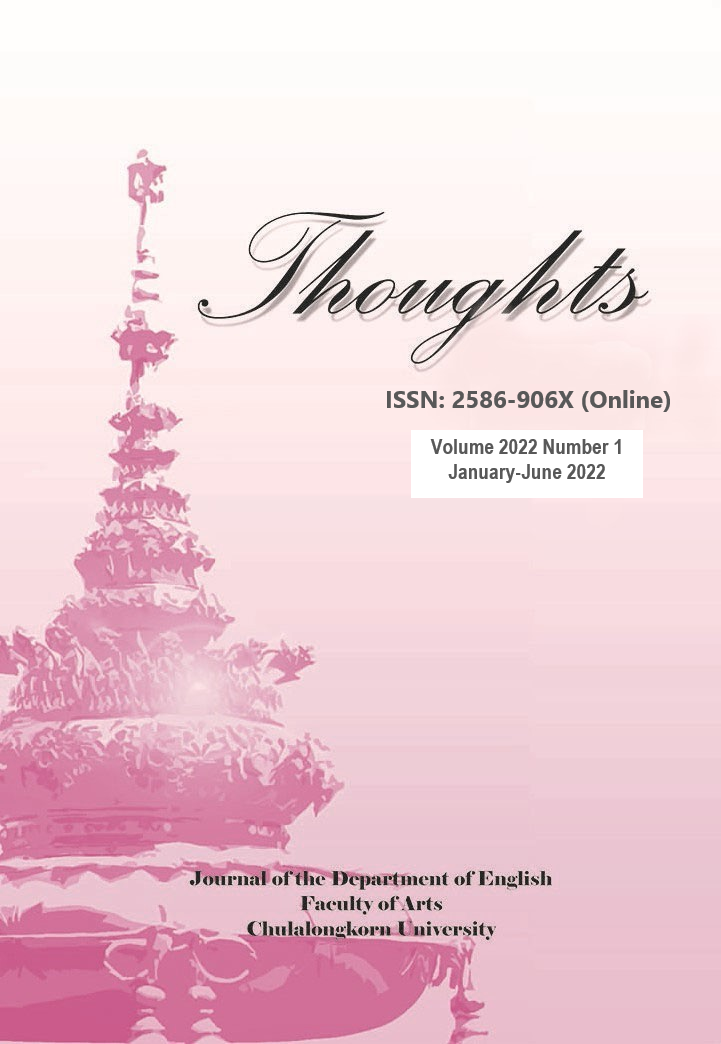Friend of Foe: The Development of Human-Alien Relationships Based on Ecological Awareness in Andy Weir’s Project Hail Mary
DOI:
https://doi.org/10.58837/CHULA.THTS.2022.1.2Keywords:
science fiction, alien, coexistence, ecocriticismAbstract
This paper discusses human perceptions of nature and nonhuman species as demonstrated in Weir’s sci-fi novel Project Hail Mary (2021) through the development of interspecific relationships between humans and aliens. By doing so, theoretical ideas such as ecocriticism and affect theory are applied. The essay questions the roles of two alien beings in the science fiction as a cause of humans’ different emotions and reactions when aliens appear and how those responses unfold humans’ attitudes to other species and the natural environment. The investigation reveals that humans interact with the emergence of aliens differently depending on the collective emotion towards two aliens although they both are unknown beings. Arguably, it reveals human indifference towards the natural environment when they fear one of the alien beings and attempt to annihilate that alien to save humanity in spite of the substantially destructive impact on the whole ecosystem. At the same time, the protagonist’s encounter and amicable relationship with another alien suggests that, instead of causing destruction, the promising way to live with other species and to solve any issues is to learn to live with it.
References
Adolphs, R. (2013). The biology of fear. Curr Biol, 21;23(2), R79-R93. https://doi.org/10.1016/j.cub.2012.11.055
Ahmed, S. (2004). Affective economies. Social Text, 22(2), 117-139. https://muse.jhu.edu/article/55780
Ahmed, S. (2014). The cultural politics of emotion (2nd ed.). Edinburgh University Press.
Alt, C. (2014). Extinction, extermination, and the ecological optimism of H. G. Wells. In G. Canavan & K. Stanley (Eds.), Green planets: Ecology and science fiction (pp. 25-39). Wesleyan University Press.
American Psychological Association. (n.d.). Affect theory. In APA Dictionary of Psychology. Retrieved November 13, 2021, from https://dictionary.apa.org/affect
Arney, J. (2014, August 11). cornucopian. In Encyclopedia Britannica. https://www.britannica.com/topic/cornucopian
Arnold, J., Buell, L., Cohen, M. P., Dixon, T., Dodd, E., Estok, S. C., Heise, U. K., Levin, J., Murphy, P. D., Parra, A., Slaymaker, W., Slovic, S., Sweet, T., & Westling, L. (1999). Forum on literatures of the environment. PMLA, 114(5), 1089–1104. https://doi.org/10.2307/463468
Bauer, L. B., Casper, C.-C., Klaubert, H., & Tabouratzidis, A. S. (2021). Introduction: Ecocriticism and narrative form. SubStance, 50(3), 3-13. https://doi.org/10.1353/sub.2021.0015
Boslaugh, S. E. (2016, January 11). anthropocentrism. In Encyclopedia Britannica. https://www.britannica.com/topic/anthropocentrism
Buell, L., Heise, U. K., & Thornber, K. (2011). Literature and environment. Annual Review of Environment and Resources, 36, 417-440. https://doi.org/10.1146/annurev-environ-111109-144855
Bühler, B. (2019). Other environments: Ecocriticism and science fiction (Lem, Ballard, Dath). In F. Middelhoff, S. Schönbeck, R. Borgards & C. Gersdorf (Eds.), Texts, Animals, Environments: Zoopoetics and ecopoetics (pp. 127-138). Rombach Verlag KG.
Cambridge University Press. (n.d.). Alien. In Cambridge Dictionary. Retrieved November 18, 2021, from https://dictionary.cambridge.org/dictionary/english/alien
Clark, T. (2020). Ecological grief and anthropocene horror. American Imago, 77(1), 61-80. https://doi.org/10.1353/aim.2020.0003
Comtesse, H., Ertl, V., Hengst, S. M. C., Rosner, R., & Smid, G. E. (2021). Ecological grief as a response to environmental change: A mental health risk or functional response? Int J. Environ. Res. Public Health, 18(2), 734. https://doi.org/10.3390/ijerph18020734
Denchak, M. (2019, July 16). Greenhouse effect 101. NRDC. https://www.nrdc.org/stories/greenhouse-effect-101#consequences
Emmet, R. S., & Nye, D. E. (2017). The environmental humanities: A critical introduction. The MIT Press.
Feder, H. (2010). Introduction: Ecocriticism and biology. Configuration, 18(1-2), 1-13. https://doi.org/10.1353/con.2010.0001
Fromm, H. (1996). From transcendence to obsolescence: A route map. In C. Glotfelty & H. Fromm (Eds.), The ecocriticism reader: Landmarks in literary ecology (pp. 30-39). The University of Georgia Press.
Gajewska, G. (2021). Ecology and science fiction. Managing imagination in the age of the anthropocene. Przegląd Kulturoznawczy, 47(1), 79-97. https://doi.org/10.4467/20843860PK.21.005.13459
Gammon, K. (2021, June 23). US navy’s powerful shock exercise harms marine mammals, expert says. The Guardian. https://www.theguardian.com/us-news/2021/jun/23/us-navy-shock-exercises-marine-life
Glotfelty, C. (1996). Introduction. In C. Glotfelty & H. Fromm (Eds.), The ecocriticism reader: Landmarks in literary ecology (pp. xv-xxxvii). The University of Georgia Press.
Heise, U. K. (2006). The Hitchhiker’s guide to ecocriticism. PMLA, 121(2), 503-516. http://www.jstor.org/stable/25486328
Iovino, S. (2018). (Material) ecocriticism. In R. Braidotti & M. Hlavajova (Eds.), Posthuman glossary (pp. 112-115). Bloomsbery.
Leys, R. (2010). How did fear become a scientific object and what kind of object is it? Representation, 110(1), 66-104. https://www.jstor.org/stable/10.1525/rep.2010.110.1.66
Love, G. A. (1996). Revaluing nature: Toward an ecological criticism. In C. Glotfelty & H. Fromm (Eds.), The ecocriticism reader: Landmarks in literary ecology (pp. 225-240). The University of Georgia Press.
Magee, R. M. (2012). Reintegrating human and nature: Modern sentimental ecology in Rachel Carson and Barbara Kingsolver. In D. A. Vakoch (Ed.), Feminist ecocriticism: Environment, women, and literature (pp. 65-76). Lexington Books.
Mambrol, N. (2016, November 27). Ecocriticism: An essay. Literariness. https://literariness.org/2016/11/27/ecocriticism/
Massumi, B. (2005). Fear (The spectrum said). Positions: East Asia cultures critique, 13(1), 31-48. https://muse.jhu.edu/article/185296
Page, M. (2014). Evolution and apocalypse in the golden age. In G. Canavan & K. S. Robinson (Eds.), Green planets: Ecology and science fiction (pp. 40-55). Wesleyan University Press.
Plumwood, V. (2003). Feminism and the mastery of nature. Taylor & Francis. (Original work published 1993)
Siegel, E. (2017, August 24). Afraid of aliens? The science doesn’t back you up. Forbes.
Singer, P. (2015). Animal Liberation. Open Road Media. (Original work published 1975)
Sterling, B. (2021). Science fiction. In Encyclopedia Britannica. www.britannica.com/art/science-fiction
Tidwell, C. (2018). Ecohorror. In R. Braidotti & M. Hlavajova (Eds.), Posthuman glossary (pp. 115-117). Bloomsbery.
Weir, A. (2021). Project Hail Mary. Ballantine Books.
Downloads
Published
Issue
Section
License

This work is licensed under a Creative Commons Attribution-NonCommercial-NoDerivatives 4.0 International License.
Copyright by the Faculty of Arts, Chulalongkorn University.
Photocopying is allowed for internal, non-commercial use only. Photocopying for other uses or for purposes other than indicated must be permitted in writing from the Faculty of Arts, Chulalongkorn University.
All views or conclusion are those of the authors of the articles and not necessarily those of the publisher or the editorial staff.


